
* Corresponding author. Tel: +98-912-1880060
E-mail address:sjsadjadi@iust.ac.ir (S. J. Sadjadi)
© 2019 by the authors; licensee Growing Science, Canada
doi: 10.5267/j.ccl.2019.003.001
Current Chemistry Letters 8 (2019) 97–116
Contents lists available at GrowingScience
Current Chemistry Letters
homepage: www.GrowingScience.com
A survey on application of MOFs in chemistry
Seyed Jafar Sadjadia* and M. Reza Naimi-Jamalb
aDepartment of Industrial Engineering, Iran University of Science and Technology, Tehran, Iran
bDepartment of Chemistry, Iran University of Science and Technology, Tehran, Iran
C H R O N I C L E A B S T R A C T
Article history:
Received January, 2019
Received in revised form
February 25, 2019
Accepted March 15, 2019
Available online
March 15, 2019
Metal–organic frameworks (MOFs) are combinations of metal ions or clusters accommodated
to organic ligands to shape different dimensional structures. MOFs are considered as a subclass
of coordination polymers, with the possible characteristics that they are normally porous. The
metals are considered to offer flexible, co-ordination environment under virtually various
topologies. Besides, because of the usual liability of metal complexes, the shape of the
coordination bonds between the metal ions and the organic linkers can be reversible and this
helps the rearrangement of metal ions and organic linkers through the process of
polymerization to give highly ordered framework structures. The study has indicated that
MOFs has maintained extensive applications in Biological imaging and sensing, Drug delivery
systems, Methane storage, Semiconductors, Bio-mimetic mineralization, Carbon capture,
Desalination/ion separation, Water vapor capture and Ferroelectrics and Multiferroics. This
paper presents a scientometrics study on 1273 papers published articles, books, patents, etc.
indexed in Web of Science database over the period 2001-2019. The study presents the most
popular keywords used in the literature, determines the network of scientific scholars and
discusses the clusters of keywords used for different surveys. The results indicate that metal-
organic frameworks and zeoitic imidazolate frameworks are two keywords considered as
motor keywords in MOFs studies.
© 2019 by the authors; licensee Growing Science, Canada.
Keywords:
Chemistry
Scientometrics
Bibliography
Metal–organic frameworks
(MOFs)
1. Introduction
Metal–organic frameworks (MOFs) have attracted much attention in different aspects of chemistry,
since their first report in 1995 by Yaghi et al.1. They are combinations of metal ions or clusters
accommodated to organic ligands to shape different dimensional structures. MOFs are considered as a
subclass of coordination polymers, with the possible characteristics that they are normally porous1-10.
The metals are considered to offer flexible, co-ordination environment under virtually
various topologies11-20. Besides, because of the usual liability of metal complexes, the shape of
coordination bonds between the metal ions and the organic linkers can be reversible and this helps the
rearrangement of metal ions and organic linkers through the process of formation to give a highly
ordered framework structure. MOFs are normally formed under solvothermal or hydrothermal
conditions in pure N,N-diethylformamide or N,N-dimethylformamide implemented as solvents. The
organic linker molecules react with metal salts and generates 3D metal-organic networks21-50. Fig. 1
demonstrates a typical MOFs structure.

98
+
Organic linkers Metal ions or clusters Metal organic frameworks
Fig. 1. The structure of a typical MOFs structure
Metal ions include void orbital’s which describes their coordination number with size and shape of
pores by prescribing how many ligands have to bind to the metal and plays as the secondary building
units to build open crystalline frameworks with enduring porosity51-70. The organic units are di or tri
organic amines, carboxylates, amylates, etc. and once connected to metal-containing units, result
architecturally robust crystalline MOF structures with some special porosity, generally bigger than 50%
of the MOF crystal volume. They have been determined as a class of “porous polymeric materials”
including metal ions combined with organic bridging ligands, and they have become a new
development on the interface between materials science and molecular coordination chemistry71-120.
MOFs have been extensively used in different industries such as drug industries, medical devises, gas
storage, sensors, etc. MOFs applications in the area of biomedical science have also been extensively
explored. The preliminary investigations of MOFs in this field demonstrate a promising role for
biomedical tools. Stability and the toxicology of the material are considered as the main challenges
which ought to be investigated when MOFs are applied in this area. Since a significant number of
MOFs have been synthesized to date, it is hard to make a conclusion on the stability of the MOFs. For
example, MIL (Fe-MOFs) family has been considered as a unique one for the purpose of storage of
biologically essential molecules. The imaging and drug components have to be directly included into
the MOFs either as metal-connecting points or as bridging ligands when we perform the MOF
synthesis120-199. Medical imaging such as MRI depends entirely on big doses of contrast agents to
substantiate between normal and diseased tissues. MOFs are biodegradable and their high porosity
makes them suitable for targeted delivery of entrapped agents.MOFs have also the capability to resolve
different challenges of selectivity that plague other sensor instances and form the basis of strongly-
sensitive and compact sensing devices. MOFs maintain some special characteristics, for instance,
mesoporous MOFs MIL-100 and MIL-101 adsorb significant amounts of CO2 and CH4 8-11.
Furukawa et al.2 is believed as one of the best known studies on the applications of MOFs in different
industries. They performed a review on the structures devised and explained the design strategies which
help groups of materials be synthesized and modified with almost the same framework topology but
different in pore type and size of functional families present on the linkers2. Ockwig et al.2,30 analyzed
the structures of all 1127 three-periodic extended MOFs existed in the Cambridge Structure Database
and determined their underlying topology. Tranchemontagne et al.4,22,31,126 provided an essential review
of transition-metal carboxylate clusters which could serve as secondary building units (SBUs) towards
construction and synthesis of MOFs. Rosi et al.5,100 presented the benefits of the idea of rod secondary
building units for the design and synthesis of MOFs. Henninger et al. 43,96 discussed the applications of
MOFs as adsorbents for low temperature heating and cooling tools. According to Fromm et al.44,
“Alkali and alkaline earth metal cations are recognized for their ionic chemistry in aqueous medium,
and a varying coordination number, based on the size of the binding partners as well as on electrostatic
interactions between the ligands and the metal ions. This makes the strategic synthesis of coordination
polymer networks with these metal ions a challenge and explains why few systematic results in the
generation of metal–organic frameworks (MOFs) are found in the literature”. They presented a
comprehensive review on some results in the field, bringing together the systematic approaches with
results obtained by serendipity, to provide an overview on current and future works which could be

S. J. Sadjadi and M R. Naimi-Jamal / Current Chemistry Letters 8 (2019)
99
accomplished. Papaefstathiou and MacGillivray44 shed light on the design and synthesis of cavity-
containing and porous MOFs with emphasis on techniques, which helps the functionalization of interior
void spaces with organic groups. They also discussed a class of MOFs, recognized as inverted IMOFs,
which enables organic functionalization using principles of supramolecular chemistry. According to
Keskin and Kızılel26,46, we see a growth on studies associated with MOFs in a numerous applications
in chemical engineering, chemistry, and materials science, including gas storage, gas separation,
catalysis and also biomedical applications. There has been a substantial progress of implementing
MOFs as a platform in biomedical applications because of their high drug loading capacity,
biodegradability, and versatile functionality. Keskin and Kızılel 26,46 explained substantial potentials of
MOFs for development and implications in biomedical applications by explaining issues including
stability, toxicology, and biocompatibility. Wang and Cohen7,32,77 investigated the modification of
MOFs in a postsynthetic scheme, where it is modified with chemical reagents with conservation of the
lattice structure. Farha and Hupp8 showed the rapid separation of desired MOFs from crystalline and
amorphous contaminants cogenerated during synthesis according to their various densities. They also
described the mild and effective activation of initially solvent-filled pores with supercritical carbon
dioxide, resulting usable channels and high internal surface areas.
The study has indicated that MOFs has maintained extensive applications in Biological imaging and
sensing, Drug delivery systems, Methane storage, Semiconductors, Bio-mimetic mineralization,
Carbon capture, Desalination/ion separation, Water vapor capture and Ferroelectrics and Multiferroics.
This paper presents a bibliographical survey on development of MOFs applications in different
industries. The study has extracted 1273 records of information indexed in Web of Science and
analyzed them using a scientometrics tools named Biblioshiny in R-software package. The study also
reviews some the highly cited articles and discuss future trends based on the information collected from
the software.
2. The bibliographic study
2.1. The themes in reviewed articles
The search of articles on the Web of Science database has been accomplished with a keyword
“MOFs in chemistry” and there were 1273 articles, patents, books, proceeding, etc. associated with the
keyword. The purpose of this study was to do search on highly cited references in this area. Table 1
demonstrates some of the most cited references associated with the application of MOFs applications
in chemistry. As we can observe from the results of Table 1, chemistry, design, MOFs, coordination
polymers and adsorption are some of the well-recognized keywords used in the literature. Fig. 2
presents the factorial analysis of the survey and as we can observe there are two groups of words used
in this survey among researchers.
Table 1
The most popular keywords used in studies associated with mesoporous materials
Words Occurrences Words Occurrences
chemistry 601 pore-size 39
design 340 clusters 37
metal-organic frameworks 264 nets 37
coordination polymers 251 units 34
adsorption 173 growth 33
complexes 157 frameworks 32
hydrogen storage 145 methane storage 32
MOFs 131 construction 31
separation 108 single-crystal 31
crystal-structures 99 thin-films 31
zeolitic imidazolate frameworks 90 hydrogen 30
Storage 89 catalysts 29
crystal-structure 83 exchange 29
networks 78 MOF 29

100
Words Occurrences Words Occurrences
catalysis 77 porosity 29
carbon-dioxide 76 solid-state 29
secondary building units 74 temperature 29
building-blocks 67 CO2 28
magnetic-properties 67 crystal 28
porous coordination polymers 65 molecular-dynamics simulations 28
topology 62 oxidation 28
molecules 61 coordination 27
solids 61 functional-groups 27
sorption 61 porous materials 27
metal-organic framework 60 surface 27
network 60 gas-adsorption 26
ligands 59 heterogeneous catalysts 26
polymers 57 porous solids 26
coordination polymer 56 organic frameworks 25
reticular chemistry 56 porous coordination polymer 25
stability 56 postsynthetic modification 25
acid 53 adsorption properties 24
ligand 52 architectures 23
functionalization 50 performance 23
surface-area 48 capture 22
water 48 complex 22
carbon-dioxide capture 47 room-temperature 22
hydrothermal synthesis 47 asymmetric catalysis 20
sorption properties 47 functionality 20
crystals 46 self-assembled monolayers 20
nanoparticles 46 efficient 19
sites 43 hydrogen adsorption 19
building units 40 MOF-5 19
drug-delivery 40
Fig. 2. Factorial analysis
2.2. Country Scientific Production
Fig. 3 presents the distribution of scientific production by various countries and as we can observe,
the largest scientific productions are associated with United States and China. In other words, 1143
works which represent nearly 90% of the published scientific works have been accomplished in United
States and China.

S. J. Sadjadi and M R. Naimi-Jamal / Current Chemistry Letters 8 (2019)
101
Fig. 3.
Country Scientific Production
2.3 Corresponding author's country
Our survey demonstrates that researchers from the United Stated and China have maintained the
most contribution in this field followed by the researchers from Germany, India and France. Fig. 4
shows the details of our survey. Moreover, we see a good collaboration between most countries with
other countries.
Fig. 4. Corresponding author's country
2.4. The frequency distribution of sources
In this research, most articles from the sources shown in Fig. 5 are CrystEngComm with 106 articles
followed by J. Am. Chem. Soc. with 105 articles.
0 20 40 60 80 100 120 140
CHINA
GERMANY
SPAIN
UNITED KINGDOM
AUSTRALIA
IRAN
PORTUGAL
FINLAND
BELGIUM
POLAND
N. of Documents
Countries
Corresponding Author's Country
Single Country Publications Multiple Country Publications










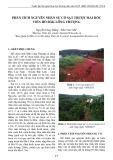







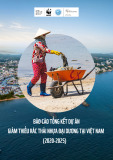
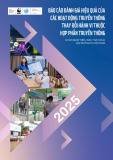
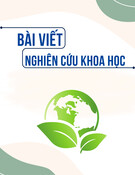


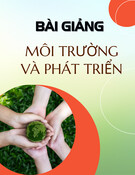

![Ô nhiễm không khí từ nông nghiệp: Thách thức toàn cầu và định hướng hành động [Mới nhất]](https://cdn.tailieu.vn/images/document/thumbnail/2025/20250917/kimphuong1001/135x160/52891758099584.jpg)
